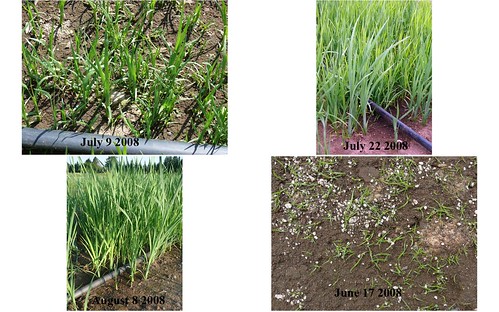
Cattails are a common, sometimes weedy aquatic plant often seen in roadside ditches. We have been growing cattail or Typha latifolia at our farm to supply demand for ecological restoration and for biological water treantment.
What is striking about this plant is the rate of growth. Shown above are plants as the were seeded in first week of June, 2008. Over 2 1/2 months these plants have grown to specimens that can easily be transplanted into projects from fall to following spring. Spring would be better since the soil will be warm and roots active. Otherwise visiting geese and ducks will have lunch.
Pollution control

Especially interesting here is the yellow stripe viewed in this cattail seed bed. Here is evidence these plants are especially nitrogen hungry, The stripe is adjacent to the drip tape and is caused by leaching of soluble nitrogen in our sandy loam soil. Two days earlier this bed was treated with Urea and this effect has already almost disappeared. Images above only give a impression of the rate of growth of these plants.
Think of the water purification potential that cattails offer. In addition the stems have sugar and rhizomes starch offering biomass energy potential, and with harvest not only are nitrates and phosphates removed but also are heavy metals and other contaminants.
See this article by Cristian Frers, English language translation by Fourth Corner Nurseries. The Use of Aquatic Plants to Treat Waste Water
Another serious nitrogen consumer - Juncus ensifolius, Dagger-leaf rush

This is one of many other plants with potential for final water cleanup after passing through cattails


This is incredible. Not only is it addressing alternative energy but waste disposal. And all with natives. Wow!
ReplyDeleteI hope you don't get lost down there is S America. Don't want to lose my filbert picking partner.
Ken